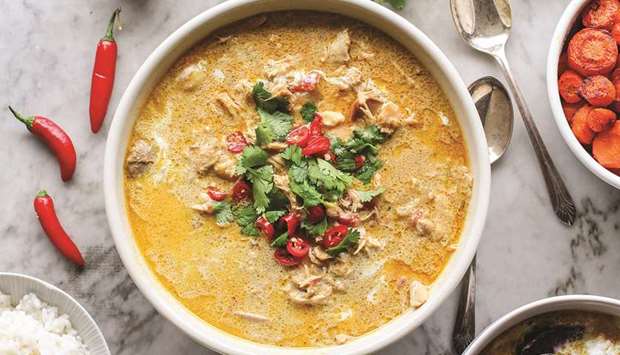The story of Malaysian food is like that of the nation’s history, it is a composition of travellers in the region and is highly influenced by the neighbouring countries. The food itself played a major part in that history. Rich in spice with kaffir lime, turmeric, ginger, black pepper, coriander and lemongrass, Malaysia is a hub of different cultures, each of which has brought in different flavours to create a distinct and vibrant cuisine.
Today, I will share my culinary insights about the Malaysian peninsula. Malay food is strong, spicy and aromatic and combines the rich taste of the many fresh herbs and spices commonly grown in Southeast Asia. There is a heavy influence of Indian and Chinese cuisine, and the Malaysian food can be called a fusion of these cuisines.
Malaysia is comprised of 13 states and is home to predominantly Malays, Chinese and Indians; the population is a wonderful hub of cultures and ethnic groups, making the gastronomy here an exciting blend of spices, flavours and cooking techniques. Historically Malaysia was an important 15th century spice trade centre which makes it a special food hub.
The welcoming and hospitable nature of the Malay culture has meant that the influx of different nationalities has been portrayed through their cuisine with ingredient choices taking influence from the north and east. Chinese influencers can be seen using soy sauce and noodles throughout the peninsula. Immigrants from Thailand are seen using lemongrass and galangal and ginger. Immigrants from India have added roti to the cuisine.
Although there are so many attributes about the Malay cuisine, the peninsula has accumulated all of the best aspects of these neighbouring cultures and combined them in harmony to form a distinct food destination.
Just as in many other Southeast Asian cuisines, rice is the staple diet and is usually eaten together with a meat and vegetable curry and condiments like samba sauce. The dishes are placed in the centre of the table to be shared by all the diners.
As is the case with all the sea faring people, the Malays include a lot of seafood in their diet. Almost all the varieties of seafood are equally enjoyed, like shrimps, fish, squid, snails, mussels and crabs to name a few. The stews and curries prepared in the region include fresh herbs and spices that are commonly grown in the Southeast Asian region. The vegetables are usually stir fried to preserve their crunch and retain the nutritional value, colour and taste. One common condiments that is served along most of the dishes is sambal belachan, a spicy chilly condiment. Lemongrass, shallots, ginger, chilies and garlic are the main ingredients that are blended together to make a sambal sauce or chili paste.
Fresh leaves like panda (screwpine leaves) and laksa add a unique and distinct taste and zest to the curries. Galangal, turmeric and kafir lime leaves are also used in abundance. Dried spices are also used in conjunction with the abundant fresh ingredients available. Malacca, a city in Malaysia about 200kms from south of the capital city Kuala Lumpur, was one of the great trading centres of the spice trade in the 5th century. This in turn benefited Malay cuisine and thus this cuisine ended up using a variety of fresh and dried spices.
While talking about Malay cuisine, the role of coconut in various forms is imperative and can’t be ignored or left out. Coconut milk add a creamy richness to curries called lemark, giving them their distinctive Malaysian flavour. All the different parts of coconut in their various forms are used and nothing is left or thrown out.
With so many different influences from around the region, Malay cuisine has become an interesting and varied adventure, something that can be savoured and enjoyed with family and friends.
Malaysian Chicken Curry
Ingredients
Chicken fillet 800 gm
Peanut oil 1 tbsp
Onion 1 no
Kafir lime leaves 4-6 no
Cinnamon stick 1 stick
Star anise 2-3 no
Coconut milk 400 ml
Chicken stock 150 ml
Palm sugar 1 tbsp
Fish sauce 2 tbsp
Cilantro leaves to garnish
Jasmine rice to accompany
Curry paste
Garlic cloves, chopped 4-6 no
Red chili, chopped 4-6 no
Lemongrass, chopped 2 stalks
Ginger, chopped 1 tbsp
Shallots, chopped 4 no
Turmeric powder 1/2 tsp
Peanut oil 1 tbsp
Salt to taste
Crushed pepper to taste
Method
Wash and chop all the ingredients required for the curry paste.
Place all the paste ingredients in a food processor and process until a smooth paste forms; season with salt and pepper and keep aside.
Heat oil in a heavy bottom pan to medium heat and add chopped onion and sauté till onion softens.
Add the prepared curry paste and cook stirring for 1 minute or until aromatic. Add diced chicken, lime leaves, cinnamon, star anise, coconut milk and chicken stock.
Bring to boil, reduce heat and simmer for 30 minutes partially covered stirring occasionally.
Simmer until the sauce thickens and chicken is cooked.
Remove from heat and add palm sugar and fish sauce and stir to combine.
Adjust the seasoning and add sugar and fish sauce if required.
Serve hot over steamed jasmine rice and garnish with cilantro leaves and sambal chili paste on the side.
*Chef Tarun Kapoor, Culinary Mastermind, USA. He may be contacted at [email protected]



